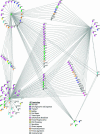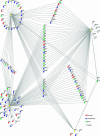Diverse functions of spindle assembly checkpoint genes in Saccharomyces cerevisiae
- PMID: 16157669
- PMCID: PMC1456180
- DOI: 10.1534/genetics.105.046441
Diverse functions of spindle assembly checkpoint genes in Saccharomyces cerevisiae
Abstract
The spindle assembly checkpoint regulates the metaphase-to-anaphase transition from yeast to humans. We examined the genetic interactions with four spindle assembly checkpoint genes to identify nonessential genes involved in chromosome segregation, to identify the individual roles of the spindle assembly checkpoint genes within the checkpoint, and to reveal potential complexity that may exist. We used synthetic genetic array (SGA) analysis using spindle assembly checkpoint mutants mad1, mad2, mad3, and bub3. We found 228 synthetic interactions with the four spindle assembly checkpoint mutants with substantial overlap in the spectrum of interactions between mad1, mad2, and bub3. In contrast, there were many synthetic interactions that were common to mad1, mad2, and bub3 that were not shared by mad3. We found shared interactions between pairs of spindle assembly checkpoint mutants, suggesting additional complexity within the checkpoint and unique interactions for all of the spindle assembly checkpoint genes. We show that most genes in the interaction network, including ones with unique interactions, affect chromosome transmission or microtubule function, suggesting that the complexity of interactions reflects diverse roles for the checkpoint genes within the checkpoint. Our analysis expands our understanding of the spindle assembly checkpoint and identifies new candidate genes with possible roles in chromosome transmission and mitotic spindle function.
Figures




Similar articles
-
Spindle checkpoint proteins and chromosome-microtubule attachment in budding yeast.J Cell Biol. 2004 Feb 16;164(4):535-46. doi: 10.1083/jcb.200308100. Epub 2004 Feb 9. J Cell Biol. 2004. PMID: 14769859 Free PMC article.
-
Two complexes of spindle checkpoint proteins containing Cdc20 and Mad2 assemble during mitosis independently of the kinetochore in Saccharomyces cerevisiae.Eukaryot Cell. 2005 May;4(5):867-78. doi: 10.1128/EC.4.5.867-878.2005. Eukaryot Cell. 2005. PMID: 15879521 Free PMC article.
-
Bub1p kinase activates the Saccharomyces cerevisiae spindle assembly checkpoint.Mol Cell Biol. 1998 May;18(5):2738-47. doi: 10.1128/MCB.18.5.2738. Mol Cell Biol. 1998. PMID: 9566893 Free PMC article.
-
Regulation of APC-Cdc20 by the spindle checkpoint.Curr Opin Cell Biol. 2002 Dec;14(6):706-14. doi: 10.1016/s0955-0674(02)00382-4. Curr Opin Cell Biol. 2002. PMID: 12473343 Review.
-
SAC-ing mitotic errors: how the spindle assembly checkpoint (SAC) plays defense against chromosome mis-segregation.Cell Motil Cytoskeleton. 2005 Jul;61(3):145-60. doi: 10.1002/cm.20072. Cell Motil Cytoskeleton. 2005. PMID: 15887295 Review. No abstract available.
Cited by
-
An S/T-Q cluster domain census unveils new putative targets under Tel1/Mec1 control.BMC Genomics. 2012 Nov 23;13:664. doi: 10.1186/1471-2164-13-664. BMC Genomics. 2012. PMID: 23176708 Free PMC article.
-
Novel sfi1 alleles uncover additional functions for Sfi1p in bipolar spindle assembly and function.Mol Biol Cell. 2007 Jun;18(6):2047-56. doi: 10.1091/mbc.e06-10-0918. Epub 2007 Mar 28. Mol Biol Cell. 2007. PMID: 17392514 Free PMC article.
-
The Forkhead transcription factor Hcm1 regulates chromosome segregation genes and fills the S-phase gap in the transcriptional circuitry of the cell cycle.Genes Dev. 2006 Aug 15;20(16):2266-78. doi: 10.1101/gad.1450606. Genes Dev. 2006. PMID: 16912276 Free PMC article.
-
Specific genetic interactions between spindle assembly checkpoint proteins and B-Type cyclins in Saccharomyces cerevisiae.Genetics. 2009 Sep;183(1):51-61. doi: 10.1534/genetics.109.105148. Epub 2009 Jul 6. Genetics. 2009. PMID: 19581447 Free PMC article.
-
The complete spectrum of yeast chromosome instability genes identifies candidate CIN cancer genes and functional roles for ASTRA complex components.PLoS Genet. 2011 Apr;7(4):e1002057. doi: 10.1371/journal.pgen.1002057. Epub 2011 Apr 28. PLoS Genet. 2011. PMID: 21552543 Free PMC article.
References
-
- Amon, A., 1999. The spindle checkpoint. Curr. Opin. Genet. Dev. 9: 69–75. - PubMed
-
- Baker, D. J., K. B. Jeganathan, J. D. Cameron, M. Thompson, S. Juneja et al., 2004. BubR1 insufficiency causes early onset of aging-associated phenotypes and infertility in mice. Nat. Genet. 36: 744–749. - PubMed
-
- Burke, D. J., D. Dawson and T. Stearns, 2000. Methods in Yeast Genetics. Cold Spring Harbor Laboratory Press, Cold Spring Harbor, NY.
-
- Cahill, D. P., C. Lengauer, J. Yu, G. J. Riggins, J. K. V. Willson et al., 1998. Mutations of mitotic checkpoint genes in human cancers. Nature 392: 300–303. - PubMed
Publication types
MeSH terms
Substances
Grants and funding
LinkOut - more resources
Full Text Sources
Other Literature Sources
Molecular Biology Databases
Miscellaneous

